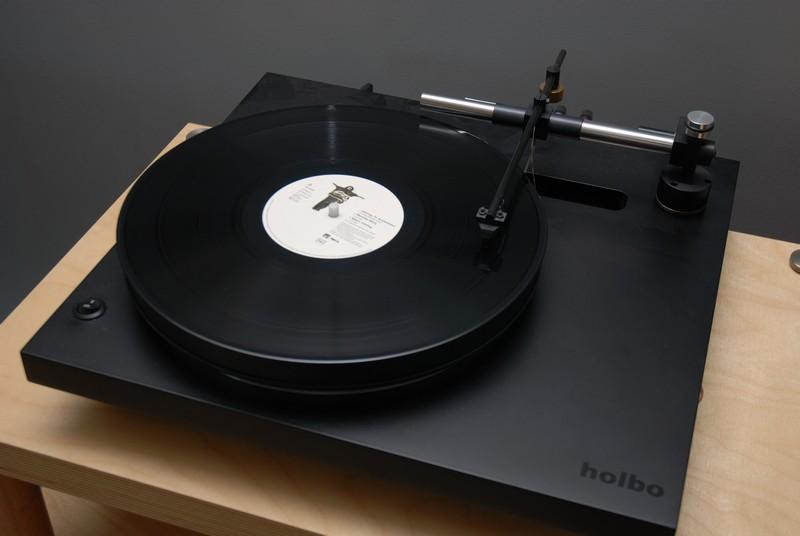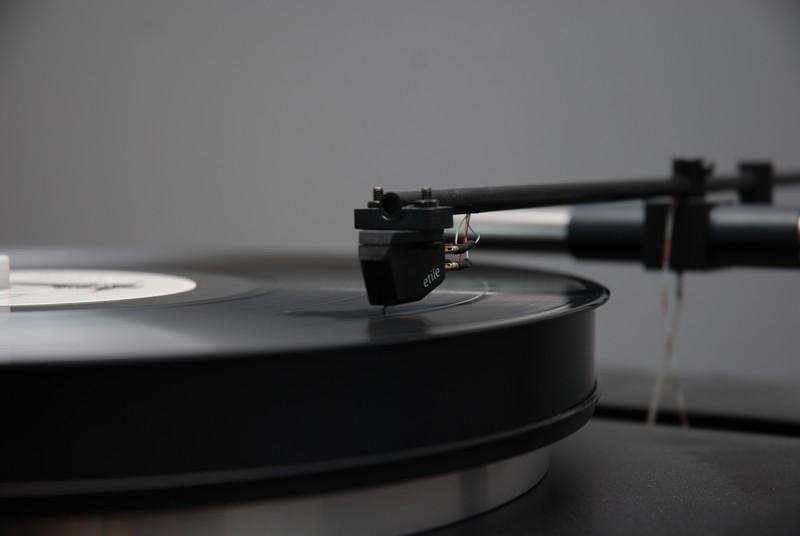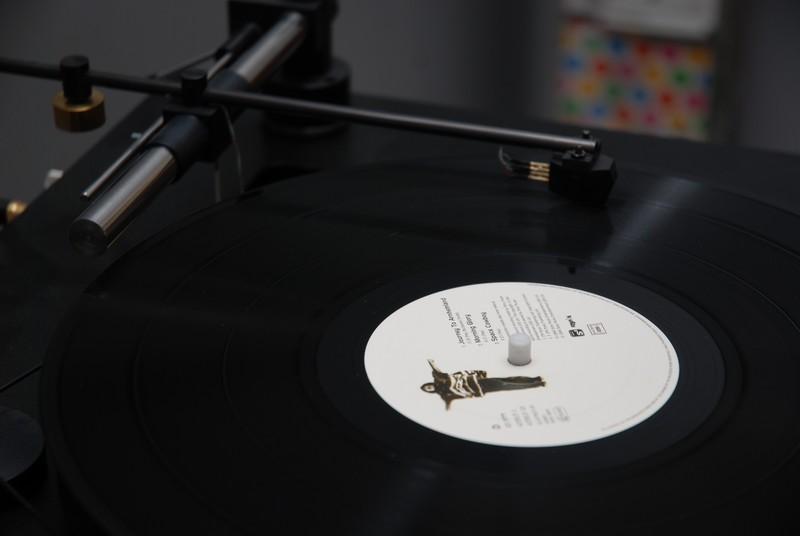Holbo Airbearing Turntable

[ Home | Staff & Contacts | HiFi Playground | Listening tests | DIY & Tweakings | Music & Books ]
Product name: Holbo Airbearing Turntable
Manufacturer: Holbo
- Slovenia
Cost: 6500 EUR (Currency
conversion) - YMMV
Reviewer: Graeme Budd - TNT
France
Reviewed: June, 2018
Over the years there have been many attempts to minimize the tracing distortion inherent in vinyl replay which we all live with and suffer with to a greater or lesser extent. Longer 12 inch and then 14 inch arms appeared on the market minimize angular distortion with the inevitable disadvantage of the turntables needing to be bigger and bigger to cope with them not to mention potential rigidity problems. Why not therefore go the whole 9 yards and embrace linear tracking which in theory if well engineered eliminates distortion over the entire side? Sounds like a superb idea until you look at the engineering required to get it to work well. Firstly you need a solid base to support the beam of the linear tracker. But you also need that solid base to not be influenced by vibration. Then you need either some form of servo mechanism to detect that the arm needs to move and perform that movement or an extremely low friction bearing to allow the record to pull the cartridge across. Again this requires high quality high precision engineering and it's down this road that we're going to be traveling today with the Holbo Airbearing turntable
Holbo is the brainchild of Bostjan Holc (no prizes for guessing where the name comes from) and is a fully integrated deck and arm combination. Bostjan has decided for his first turntable to really set the bar high by not only having a linear airbearing arm but a rotary air bearing for the platter. It would appear that reducing friction is pretty high on his list of priorities to give the arm and drive system the easiest life possible. Second priority is evidently cartridge adjustment to further optimize the system. Anyway enough with the preamble and on with the description proper.
The deck is essentially a square shape and prospective purchasers should be aware that it's quite deep so check your rack has enough real estate or be prepared to buy a new one. It's supported on three spiked feet which caught me out and I ended up scratching the top shelf of my rack. Some spike shoes similar to those Pro-ject supply would be a welcome addition here please! The feet allow precise leveling of the deck which is very easy to achieve and is very important for the linear tracker as we will see. Round the back are connections for the supplied air pump, the PSU and phono cable. There is also the 33/45 selector and the adjustment pots for these two speeds. The power switch is on the front left with a tasteful black on black Holbo logo residing in the front right corner.
Moving up from the base of the deck we come to the first of the air bearing units. The platter comes pre-assembled onto the air bearing and is nicely machined. Like the rest of the deck there's no bling but the engineering and quality is evident explaining why the deck costs what it does. Firing the deck up (once the air tube has been connected and the pump is running) it's up to speed quickly and when you switch it off the platter spins for ages showing the lack of friction in the unit. Drive is by DC driven belt drive - as with a lot of DC motors it can be heard from 2 feet away but from a normal listening position is inaudible and I think it got quieter over time but that may just be me getting used to it. Whatever the truth it isn't an issue
The most obviously unique part of the deck is the air bearing linear tracking tonearm - this consists of a stainless steel arm beam with an aluminium carriage which contains the air jet. The arm is height adjustable - even while playing for the VTA fiddlers among you - and the carbon arm wand allows tracking weight via a screw fixed brass weight and azimuth adjustments by pivoting the arm in the carriage. The arm beam can also be adjusted to get it parallel to the platter by means of the screws in the arm base
I'd normally list the system here and then go onto the listening but I'm going to break with tradition and talk about setup here as it was a frustrating but ultimately rewarding experience. Firstly ensure you've got a couple of bubble levels - a magnetic one on the arm beam is also useful. Then read the instructions. Twice. And have Bostjan's email at hand as he's really helpful when it doesn't go to plan. Then read the instructions again.
I started by installing the pump and its tube which is easy and just involves 2 screw collar fixings. The first batch version I had was a tad noisy but the tube is long enough to site it well away from the deck and in any case the new production version is apparently totally silent. Easy enough so I was expecting to be up and running quickly. Power supply - check. Phono cable - check. Belt - check. Deck leveled - check. Rack scratched - also check (see above).
Now it was time for the arm (long drum roll). And here things get a tad fiddly. Arm length is easy to adjust to get the stylus at the right point on the supplied (very clear and well made)installation gauge. But whilst doing this you need to get the azimuth right without moving the arm length. This takes time and patience and don't try it after a few glasses of Chardonnay. Tracking weight is again easy to adjust in theory but again it's a fiddly operation in reality and as everything is very light small adjustments can be significant. You then need to get the arm level which is where the magnetic level is a godsend as if you get it wrong things aren't going to work properly. You can then fire things up, check the speed (very important) and actually play some records and drink that bottle of Chardonnay you were about to start on before I told you not to. So why have I gone into the setup and the trials and tribulations I had with it? Because you need to persevere with this deck to get the best out of it and when you succeed it's very impressive

So now for the system list - the back end of the system was the Canary CA608LV and Living Voice IBXRW3s. Cabling from phono stages (CEC PH53 or Graham Slee Accession or Audio Note) to amp was Audio Origami and Hitachi LC-OFC speaker cable connected the amp to the speakers. All mains cables were Supra Lo Rad with Supra or Furutech IECs. The Audio Note TT2 Deluxe was also on hand for comparative testing.
I started off running the Holbo with the Audio Note IQ3 to allow me to run all of the phono stages I have. To be honest this was a bit of a non starter and didn't seem to gel properly. Tracking was average at best and there was no sparkle to the music with any of the phono stages - things the IQ3 is capable of. Turns out the IQ3 is a very low compliance design for an MM and isn't the best option for a linear tracker. You live and learn and my thanks to Audio Note for resolving that mystery!
So I decided to bolt up my own personal Reson Etile MC. This was looking promising until I realized the Holbo needs slightly longer than usual bolts for the headshell and I didn't have any. A quick rummage in my RC car spares boxes and bingo - 2 bolts and nuts courtesy of my Kyosho Optima Mid. Some fiddling later and I was up and running.

So was it worth it? Absolutely. The first word that springs to mind about the Holbo is precision. It's extremely detailed and digs into the most complex of mixes to bring out the ambient detail. Transients are super fast - I tried Ride Across the River from Geoff's Killers list and the Holbo managed to make the bass do the stop start thing he describes which was a first in my system. All the "noises of nature" on the track are clearly set in the background which has a huge stage height and width. As I'd enjoyed Ride across the River I let the record play on - there is a long note at the end of "The Man's too strong" which shows the Holbo to be very speed stable. The DC/Airbearing combination is obviously for something here and the I'd say this alone validates the design choice. Turning the record over and trying "So Far away" presented me with probably the clearest positioned vocals I've ever had from this album (and I play it regularly). It also clearly shows Mark Knopflers occasional deviations from the vocal rhythm and sometimes the melody...
I dug out some drum and bass to see what the Holbo can do with a rapid bass line. Flytronix's "Rare Tear Part 1" has a very real sounding snare drum and the Holbo presented some very realistic instrumental texture. As for the bass - again it's very fast and has an almost metronomic feel to it. Saxophone also had a very real feel to it with a typical rasp and combined with some 70s style muted wah pedal guitar obliged me to play the track really loudly.
The first Stone Roses album's bass lines were always well delineated and don't get lost with the guitar parts - you can always hear deep enough in the mix to hear and distinguish between the two or three parts. A few years ago there was a trend in some of the magazines to mention hearing below bass notes. Quite what this actually meant had always puzzled me but I think the Holbo has managed to clarify this idea to me - I might be wrong but it seems it describes the concept that all the bass note is there without losing the lowest frequencies. If this sounds like rubbish to you I apologize but it's the best explanation I can come up with.
This is definitely a clean sounding deck - I have a 12" picture disc of Nirvana's "In bloom" - normally this has me abandoning mid song. In the case of the Holbo I got to the end of the record without the usual harshness and all the while not fattening things up or dulling tone.I have no way of proving the linear tracker is responsible for this but it was great to not notice (ineveitable?) end of side sharpening of the sound.
Niggles? Well there are a couple. The lack of arm finger lift always had me worried that I was going to bash something and damage it. The lack of any form of lid (this is not unique to the Holbo although the lack of arm clip in this case potentially increases the risk of damage) always worries me so I bought a turntable cover from sora-shop.com - I'll review it at a later date but it would appear to be a good solution for all you with lid less turntables and at a very reasonable price (1% of the turntable in this case!). The other niggle is more of a character thing than anything else. As I mentioned above the Holbo majors on speed, precision, detail and staging. You can examine individual instruments in a mix or enjoy the whole as if the band is in your front room. In my opinion it does lose out in the fluidity stakes to something like the TT-2. The Holbo will always impress you - I defy you not to be but if you're a Linn fan you may be wishing for more boogie factor.
Bostjan Holc has obviously done his Engineering homework and has come up with a very very good record player. It produces a wonderfully clean and detailed sound with fabulous instrument delineation and tone. Add to this it's staging capabilities and it's a very enticing package. I think the price is in the right ballpark and definitely well below the "high end silliness" zone. The questions I would raise are whether you will like it and whether you can accommodate it and are willing to take the time to get the best from it. If the answer is yes to the three of these then I would definitely recommend finding somewhere to hear it with an appropriate cartridge.
© Copyright 2018 Graeme Budd - Graeme@tnt-audio.com - www.tnt-audio.com
[ Home | Staff & Contacts | HiFi Playground | Listening tests | DIY & Tweakings | Music & Books ]